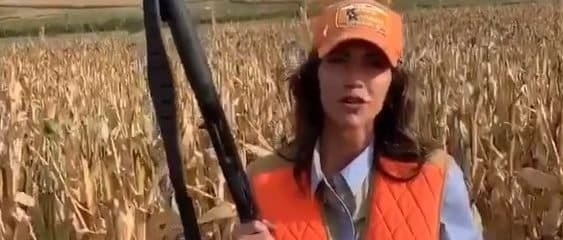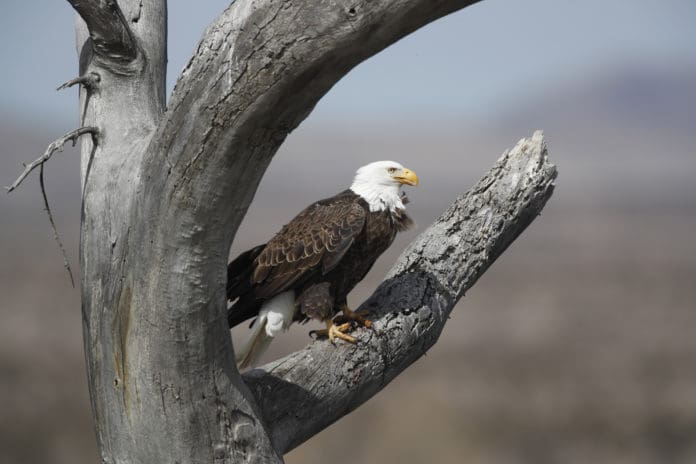Some journalists can’t help but shame the very benefactors driving the rebound of America’s bald eagle and other wildlife. They somehow get it backwards and report on the remarkable conservation successes of bald eagles but still blame hunters.
Hunting and recreational shooting sports have experienced a welcomed renaissance with record numbers of Americans heading into the fields and woods over the last 18 months. The impacts of this trend will be long-lasting for generations and America’s wildlife populations are the chief beneficiaries.
Major Money Milestone
More than $14 billion. That figure represents the major milestone surpassed earlier in 2021 of Pittman-Robertson excise taxes paid by the firearm and ammunition industries. The payments are supported every time a firearm or ammo is purchased. The funds go back to states to help fund their wildlife management and conservation projects. Since its inception in 1937, hunters and recreational shooters – America’s original conservationists – have paid more than $14.1 billion.
The funding stream has seen a boost as record numbers of Americans have joined or rejoined the hunting community. That includes scores of younger hunters who may pour hundreds or thousands of dollars each into the industry for decades to come. So many younger Americans have taken up the outdoor shooting sports that Barstool – the irreverent new-age sports media behemoth – even launched their own hunting and outdoor vertical, Barstool Outdoors. A recent article extolled hunters’ contributions to the health of wildlife populations.
Traditional media has reported on the hunting renaissance, too. State legislatures like Iowa, South Dakota, New York and others lowered minimum age limits for hunting to allow hundreds more to head afield.

South Dakota Republican Gov. Kristi Noem praised her state’s legislature for lowering the age and put the goal in simple terms. “The goal of this legislation is to get more young people involved in our outdoor way of life at an early age so they continue those experiences long into their adulthood.”
With record hunting (and fishing) license sales, as well as historic firearm sales and ammo shelves left bare, it’s no surprise wildlife management and conservation projects are getting big funding boosts. It’s no surprise America’s game populations are as healthy and numerous as they’ve ever been.
Half the Story
With all the good news happening among hunting, conservation funding and wildlife management, reporters still attempt to shame hunters who are helping the cause. One report praised the remarkable rebound of the American bald eagle from the brink of extinction. It includes the U.S. Fish and Wildlife Service announcement that there are more than 316,000 eagles soaring in U.S. skies.
It never mentions, however, Pittman-Robertson, wildlife funding or the fact that hunters support the population growth through their purchases. Instead, it bemoans the ills of traditional ammunition and shames hunters for using it.
California’s San Luis Obispo Tribune joined in with a similarly slanted article, reporting on California condors experiencing lead poisoning caused by hunters. Yet traditional ammunition was banned in the condor’s home region back in 2013 and further banned for hunting in the entire state since 2019.

Traditional ammunition is practical and provides a less-expensive option for the largest number of America’s hunters, young and old, to continue enjoying the great pastime. Efforts to reduce lead left afield continue as well, including education and emphasizing burying or removing gut piles once game is harvested.
Thousands of new hunters and outdoorsmen and women are joining America’s greatest sporting pastime each month. They are doing their part to help continue the traditions of hunting and recreational shooting for years to come. Those efforts have contributed billions of dollars to ensure America’s wildlife populations reach new heights and have never been healthier. That’s the story to keep telling.
Larry Keane is SVP for Government and Public Affairs, Assistant Secretary and General Counsel of the National Shooting Sports Foundation.





Jim Crow Gun Control joe rambles on about his stupid climate change based economic plan FIRST while Americans cowering in fear of the Taliban are mentioned SECOND. The big numbers JCGCj claims have left by plane do not match those reporting on the ground from Afghanistan.
That eye sqenting lying democRat pos needs to be removed from office along with every stinking democRat. They are covering for a ratbassturd who says one day the buck stops with him and the next day blames his predecessor who is 8 months and miles away.
Just as bad are the useful idiots who give such filth a pass.
So, since I’ve not traditionally hunted in many years now and have instead engaged in defensive/tactical training, the taxes I’ve paid on the (tens of) thousands of rounds for training have been used for others. I’m all for conservation, don’t get me wrong, but this is kinda like paying property taxes to pay for construction of a new school on the other side of town long after my own kids are grown. I lean more toward direct pay-as-you-play fees. If I choose to hunt and my neighbor does not, there’s no reason he should be paying to support my decisions, and vice versa.
“I lean more toward direct pay-as-you-play fees.”
To raise that much money, hunting and fishing licenses would have to cost thousands every year. Either that, or income taxes would have to be increased to cover the cost. If neither, then conservation suffers.
When the feds pay for a highway in Dubuque, people in Boston pay for it too, even though they will never use it. That’s the way things work.
Well aware of the machinations of the taxation system, Ralph. Still don’t agree with all applications. If you choose to exercise in an activity, and I don’t (and never will), it’s not a fair playing field to have me pay for your decision.
Pittman-Robertson is fraud. Plain and simple. There is no reasonable connection between defensive firearms and wildlife conservation.
Conservation is good, but Pittman-Robertson is morally wrong.
It is just one more of the multitudes of BS taxes that we pay, and is nothing to brag about.
Taxation Witbout Representation it used to be called.
Now, our Congress calls it something different, but that’s really all it is.
“Over the past half-century, the number of hunting licenses sold annually in California has fallen 70 percent — from 764,000 in 1970 to 225,000 in 2019, even as the state’s population has doubled. So to maintain wilderness areas, the state has been forced to raise the remaining hunters’ fees, pricing many of them out of the market.”
“With waning public interest, an ever-shrinking number of hunting grounds because of urbanization, stricter gun laws and the loss of family traditions, fewer Californians are hunting than ever before — less than 1% of the population, compared with 4% nationally.”
What appears to be supporting conservation now seems to be the fear of urban crime, since the tax applies to any type of firearm or ammunition.
Why is Gun Culture 2.0 being taxed for the Fudds?
When I hunt I buy a hunting (tax) license.
The Pittman-Robertson $14 billion is not being spent on target shooting, training or self defense. I suspect it is being spent to hinder us in many places.
“The power to tax is the power to destroy.” Justice John Marshall, McCulloch v. Maryland (1819)
The general public has always (in my 60 years) had misconceptions of Hunting. It’s entirely due to a lack of education, and mis/disinformation from the Anti-Hunting/Anti-Gun crowd.
The people down on Hunting, haven’t witnessed the herd die offs from overcrowding/starvation.
I live in Colorado, on the Front Range, in a town of about 170,000. Right now, I’ve a Mule Doe and 2 Fawns in my backyard. She decided the grove of trees in the back was a good nursery. We supplement her feed (legal as long as there’s no attempt to harvest or tame), to keep her from roaming the neighborhood and out of a very busy street nearby (and we don’t want to see the fawns become orphans). I mention this, because this is a Mule Deer in the ‘Burbs, not a Whitetail. We’ve had Whitetails for decades, but now, in the last 3 to 4 years, Muleys have pushed the Whitetails out (I haven’t seen any Whitetails in the last 3 years). Something has changed for this to occur. Whether this is a good thing or not, only time will tell, I suspect it’s not a good change, as I’ve never seen Mule Deer this low in my life. We didn’t even bother to plant a garden this year, as last year, they decimated it.
It will be interesting to see if a trend has started, and I’d really like to know what factors caused this shift.
Also, in the last 3 years, we’re seeing Chukar on the Front Range. Chukar, used to be a West of the Continental Divide Game Bird. Never East of the divide. I suspect that the Forest Fires of the last few years were the driving factor in that shift. Seeing these notoriously wily birds in town was a shock.
Latin America is very close to the United States geographically but very distant culturally. US citizens perceive Latinas as total strangers. Hence best mail order bride site many local men have no idea about the wonderful features of Latin women for marriage. As more men begin discovering the appeal of Latina girls, they start dreaming of meeting and marrying a Latin woman. So what can you expect from relationships with a Latina?
Comments are closed.